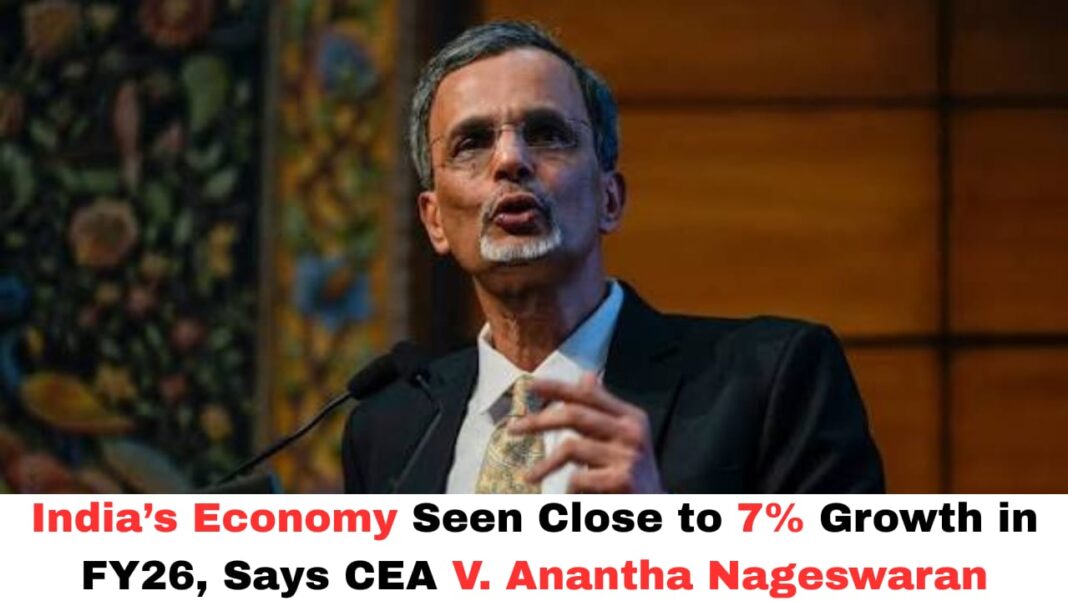Digital News Guru National Desk:
CEA Nageswaran Predicts Near 7% GDP Growth for India in FY26
India’s economy is showing encouraging signs of resilience amid a turbulent global backdrop, according to the Chief Economic Adviser to the Government of India, V. Anantha Nageswaran. In remarks made recently, he projected that the country’s gross domestic product (GDP) growth for fiscal year 2025-26 (FY26) is likely to approach 7 %.
What the CEA said
Speaking at a public event, Nageswaran noted that despite global headwinds — including inflationary pressures, trade tensions and geopolitical risks — India’s domestic economic fundamentals are holding up well. He said that the economy has “responded quite satisfactorily” and is on track to grow near 7 % in FY26.

Previously, earlier in the year, his office had indicated more conservative growth estimates in the range of 6.3–6.8 % for FY26. The updated remark suggests an uptick in confidence, assuming favourable conditions persist.
Why this matters
A growth rate close to 7 % carries multiple implications:
- Economic momentum: Sustained high growth helps drive employment, investment and government revenues. If India can maintain nearly 7 % growth it would reinforce its status among the fastest-growing major economies.
- Policy credibility: The projection signals that government and monetary policy may be effectively cushioning the economy from external shocks, reinforcing investor and business confidence.
- Global standing: A strong growth performance in a difficult global environment underlines India’s role in global value chains, and might help attract further foreign investment.
What’s underpinning the optimism
Several positive factors appear to be backing the outlook:
- Domestic demand strength: Consumption and investment appear steady enough to offset weak external demand. Nageswaran flagged the economy’s “strong domestic fundamentals”.
- Infrastructure & government spending: Large public-investment programmes and infrastructure builds continue to provide a base for growth, helping broaden the traction beyond just consumption.
- Resilience to external shocks: While global conditions aren’t easy, the Indian economy seems less reliant on goods exports and more oriented to domestic activity, giving it a degree of insulation.

The caveats & risks
However — the projection is not without its risks. Some of the key warning signs:
- Global headwinds: Trade disruptions, commodity price volatility (especially oil), and supply-chain issues remain potent threats. Though the CEA said the economy has weathered them “quite satisfactorily”, they could still intensify.
- Investment growth: Private investment has lagged in recent years; if business sentiment doesn’t pick up, sustaining high growth will become tougher.
- Inclusive growth challenge: Even if headline GDP growth nears 7 %, ensuring that this translates into jobs, wage growth and productivity gains remains a challenge. Some sectors may lag.
- Dependence on favourable conditions: The “close to 7 %” scenario likely assumes benign external conditions and smooth domestic policy execution. Any derailment could push the growth rate lower.
What to look out for
In the coming months, several developments will help assess how realistic this outlook is:
- Quarterly GDP updates: How the economy performs in Q1, Q2 of FY26 will shed light on trajectory and whether growth is accelerating or decelerating.
- Budget & policy implementation: How the upcoming budget allocates resources, and how well infrastructure and reforms are executed, will matter a lot.
- Sectoral performance: Which sectors are leading—manufacturing, services, agriculture, infrastructure? The health of these will underpin overall outcomes.
- External signals: Global growth trends, commodity prices, trade policies (especially the U.S., China) will remain critical for India’s growth story.

The bigger picture
India’s ambition to be a major economic engine of the 21st century hinges not just on high growth, but on sustainable, inclusive growth. A figure near 7 % is significant for a large economy like India’s—but what matters even more is how that growth is distributed, how productive it is, and how resilient it stays.
This projection also reflects the evolution of India’s growth model: increasingly leaning on domestic demand, infrastructure investment, and large-scale government spending rather than purely on external trade surges. That shift helps provide a buffer against global turbulence.
Final thoughts
The statement by CEA V. Anantha Nageswaran that India is on track for near-7 % growth in FY26 is both encouraging and cautious. Encouraging in that it reflects real strength in the economy’s foundations; cautious because myriad risks remain. If executed well, India could strengthen its economic position globally. But the margin for error is narrower than appears — the difference between 6.3 %, 6.8 % and 7 % can matter significantly in large-scale economic terms.
As the fiscal year unfolds, whether India can indeed hit that “close to 7 %” mark will depend on domestic momentum, global conditions, policy efficacy and how broadly growth reaches across sectors and people. For now, the signs look positive—but the work continues.
You May Also Read: 3I/ATLAS: Inside the Journey of the Third Interstellar Object in Our Solar System








